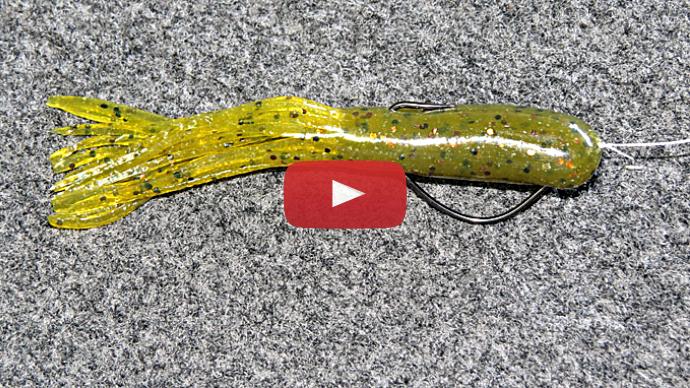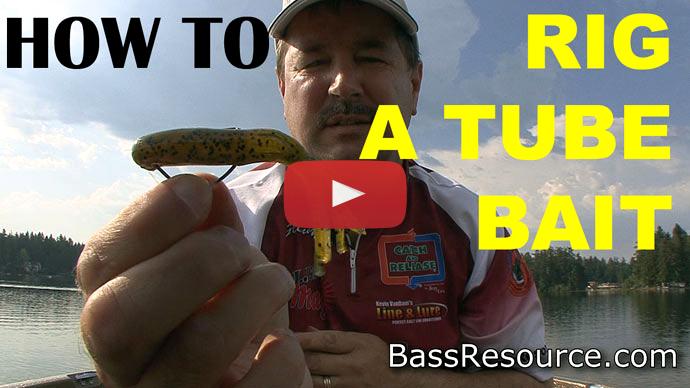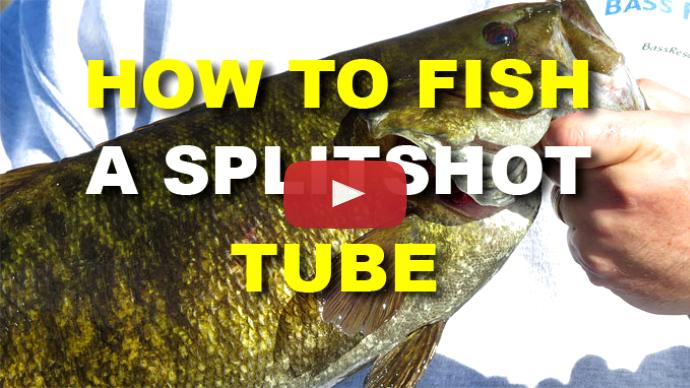Hey folks, you can't see it but under the water here is a bunch of flooded bushes and flooded cover, it's really thick underneath there. It's a big flat. The fish are up on these flats, feeding in between all that stuff. It's pretty heavy, but I'm gonna go on there and dig them out.
There we go! Come here you. This is it. Here we go. Oh don't you throw that! Come here you. Had to eat my tube didn't you? Had to eat my Texas rigged tube.
Look at this folks, look at this. Texas rigged tube. Boy he ate it! Can you see that? He ate that thing. This is what Texas rigged tubes do and we're going to talk about it on BassResource.
Hey folks. Glenn May here with BassResource.com and today I wanna talk to you about fishing tubes, the Texas rig tube specifically. And this is what we're talking about right here. If you're not sure how to rig it this way, I've got a video on rigging tubes. It's linked at the bottom of this video here underneath. You can go check that out in a little bit.
But right now I'm gonna take you through the different gear you use for this and the set up, and then I'm gonna show you how to fish it. So starting off here we're using a 2/0 hook. A lot of people ask me about this hook, "What is it Glenn?" "What are you using?" This is a Trokar TK190 hook. It's a stout, heavy duty hook. This is used for flipping and pitching. This is what I use the tubes for. This is great. A lot of people use tubes for finesse fishing. I use it for flipping.
So, we have it on that stout hook and Tungsten weight. This is an eighth ounce weight in front. Now that's a good starting point. Eighth ounce to quarter ounce weight. This is a real small bait so you don't need a heavy weight to get it through cover. It'll slide through real easy with that hanging up. So you don't need a heavy weight. You still want that nice, slow glide and slow fall. So the lighter the weight you can get away with, the better. If you're using . . . if you're throwing into real heavy, woody cover, thick bushes, that sort of thing. You might want to heavy up and maybe go to three-eighths ounce. Nothing more than that. I've never had to use any heavier than that.
On it I'm using braided line. This is 50 pound braided line. This hook can handle that without straightening it out. And again, I'm throwing it into heavy, heavy cover so I don't wanna use a lighter line than that because it can get frayed and break off if a fish tangles me up in that stuff. That's pretty much . . . I'm done. So braided line, you can turn his head and get him going towards you.
And I have that paired with a medium heavy action rod with a fast tip. And the reason I got that fast tip is to help me cast this out here. Although for the most part I'm flipping and pitching, sometimes I'll make a longer cast and want that limber tip to help me fling it out there. Plus, you want that little bit of a light tip at the end to be able to fight the fish on the way back.
It's just the bait casting off it right here. This is not absolutely the only way to fish it, but great way to go for fishing heavy cover. If you're fishing lighter cover, say lily pads and reeds and lighter vegetation, sparse vegetation, you don't need to be this heavy. You can probably get away with 15 pound copolymer line. Again, I'd still use a medium heavy action rod. Probably the same hook, it's universal, but you can go a lighter hook if you want. There's a lot of different ways to rig it. But that's what I would be doing. This is my universal way of fishing it for flipping and pitching heavy cover. All right, now you know the rigs and the gear to use, now let's go fish it.
Okay, so with a tube jig anywhere you fish a jig or a worm, you can also fish a tube. So flipping and pitching for example. All I do is I just pitch it right in there, let it drop on slack line. Watch that line see if it jumps or pops while it's dropping. Let it hit the bottom, and I just lift it back up. Let it fall right back down on slack line. Very simple. Just like you do any other worm or jig when you're flipping and pitching cover. It's a great place to throw the tube.
Now the tube it's a more subtle approach so this is a great bait to use when, say post front conditions, or when the water temperature is low, the fish are lethargic, they're not feeding, they're not very active. If you're catching fish on fast moving baits . . . Oop! Just had a bite. You're catching them on fast moving baits and they weren't biting it, the bite dies off or whatever, then go back in here with a tube, you can catch a lot of fish that way. So that's one way to do it.
Now, another way is you let it sit and just drag it on the bottom with the reel. I just point the rod tip down, I'm dragging it along and just letting it crawl on the bottom. Here I'm trying to imitate like a crawfish or maybe a sculpin, something along those lines. Some kind of a fish that's feeding off the bottom, that's what I'm trying to do. Just kind of slowly crawl along the bottom. And a lot of times the fish will pick it up just when you're doing that. Now how fast you crawl it, really depends. You're gonna have to play with it a little bit and figure out what it is the fish want.
One other way I like to fish the tube is a little bit unique to the bait itself, and that is I like to go over submerged weeds, say standing weeds. Milfoil, hydrilla, coontail, that sort of stuff, anywhere from 10 feet deep and deeper. I'll take the bait and I'll just drop it over the side of the boat here and feed it some line and get it down there towards the bottom, all right? Once it hits the bottom then what I'll do is, I'll bring the bait up a couple feet of the bottom and then I'll just dance it. Just pop it around like that. And if you're in real clear water, say 6 feet or so, 7 feet, 8 feet of visibility you can watch the fish. They'll come up and look at it. And then all you do is drop it on a slack line. Just drop it straight down until it hits the bottom. When you lift up on it a lot of times fish will have it. You attract them by bringing it up off the bottom, shaking it like this, giving it a little bit of time then straight drop. And it causes a reaction strike. They come up to it, check it out, see what's going on. They see it fall, and one of them will hit it. Great way to catch fish when they're in the weeds.
So yeah, I like to flip and pitch it in the warmer months. I do enjoy doing that but the main areas I focus on in the warmer months, and in the winter time too a lot of times, is in main lake points. I fish offshore structure like humps, rock piles, creek channels, anywhere where a creek bend comes in close to the shoreline. Those are the things I like to target in the summer time when I'm not flipping and pitching in the shallow cover like this. In the spring and in the fall, definitely go shallow then. Then I'll go in the back of creeks, in the back of coves, protected bays, secondary points, flats. Those are the type of things and again, flipping and pitching into shallow cover like this, that's the kind of stuff I like to target. If you do that using some of the techniques I just showed you you're gonna catch a lot of fish.
For more tips and tricks like this, visit BassResource.com.



